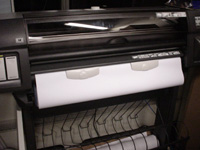
I was thinking about how women in the early-mid 1900's
went to dressmakers for the hottest fashions of the day, a concept alien
to most women and girls today. Instead, modern women rely on ready-to-wear
for a significant part (if not all) of their wardrobes, and this changes
the relationship women have with their clothing. Mass production revolutionized
the fashion industry forever, true. But it also altered our mindset about
the permanence and fluidity of our wardrobes.
I imagined being able to use technology to design and build new clothes for myself each morning before school or work. I ordered printable cotton matte from Hewlett-Packard to run through a large format inkjet printer, in hopes to print my new clothes with a sense of ease and flair that starkly constrats the highly specialized craft of the early dressmakers, who hand-tailored each small detail of a woman's garment.
I wrote a program that generates designs and styles for new skirts on the fly, write them to a postscript file, and send them off to the printer in just the flick of my hand. In a matter of minutes, nearly 15 different designs can be generated and queued up for printing.
I realized that this technique creates a dual commentary on the fabrication of fashion garments. It not only contrasts the careful constructed dressmaker's clothes due to its speed and simplicity, but it contrasts the generic clothing we yank off the racks of any local chain store because of the wearer's involvement in generating the design of the fabric. The design process behind the construction of ready-to-wear clothing is completely isolated from the customer. But does it need to be?
These images
are of a skirt I
printed and sewed together
one afternoon. The process
eliminated the step of cutting
and pinning the patterns.


related work:
Hitoshi Ujiie, professor at Philadelphia University, Artist in Residence at the Textile Museum in Washington DC